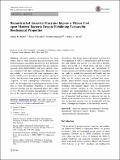Reconstructed Ancestral Enzymes Impose a Fitness Cost upon Modern Bacteria Despite Exhibiting Favourable Biochemical Properties
Author(s)
Hobbs, Joanne K.; Prentice, Erica J.; Groussin, Mathieu; Arcus, Vickery L.
Download239_2015_Article_9697.pdf (1.467Mb)
PUBLISHER_POLICY
Publisher Policy
Article is made available in accordance with the publisher's policy and may be subject to US copyright law. Please refer to the publisher's site for terms of use.
Terms of use
Metadata
Show full item recordAbstract
Ancestral sequence reconstruction has been widely used to study historical enzyme evolution, both from biochemical and cellular perspectives. Two properties of reconstructed ancestral proteins/enzymes are commonly reported—high thermostability and high catalytic activity—compared with their contemporaries. Increased protein stability is associated with lower aggregation rates, higher soluble protein abundance and a greater capacity to evolve, and therefore, these proteins could be considered “superior” to their contemporary counterparts. In this study, we investigate the relationship between the favourable in vitro biochemical properties of reconstructed ancestral enzymes and the organismal fitness they confer in vivo. We have previously reconstructed several ancestors of the enzyme LeuB, which is essential for leucine biosynthesis. Our initial fitness experiments revealed that overexpression of ANC4, a reconstructed LeuB that exhibits high stability and activity, was only able to partially rescue the growth of a ΔleuB strain, and that a strain complemented with this enzyme was outcompeted by strains carrying one of its descendants. When we expanded our study to include five reconstructed LeuBs and one contemporary, we found that neither in vitro protein stability nor the catalytic rate was correlated with fitness. Instead, fitness showed a strong, negative correlation with estimated evolutionary age (based on phylogenetic relationships). Our findings suggest that, for reconstructed ancestral enzymes, superior in vitro properties do not translate into organismal fitness in vivo. The molecular basis of the relationship between fitness and the inferred age of ancestral LeuB enzymes is unknown, but may be related to the reconstruction process. We also hypothesise that the ancestral enzymes may be incompatible with the other, contemporary enzymes of the metabolic network.
Date issued
2015-09Department
Massachusetts Institute of Technology. Department of Biological EngineeringJournal
Journal of Molecular Evolution
Publisher
Springer US
Citation
Hobbs, Joanne K. et al. “Reconstructed Ancestral Enzymes Impose a Fitness Cost upon Modern Bacteria Despite Exhibiting Favourable Biochemical Properties.” Journal of Molecular Evolution 81.3–4 (2015): 110–120.
Version: Author's final manuscript
ISSN
0022-2844
1432-1432